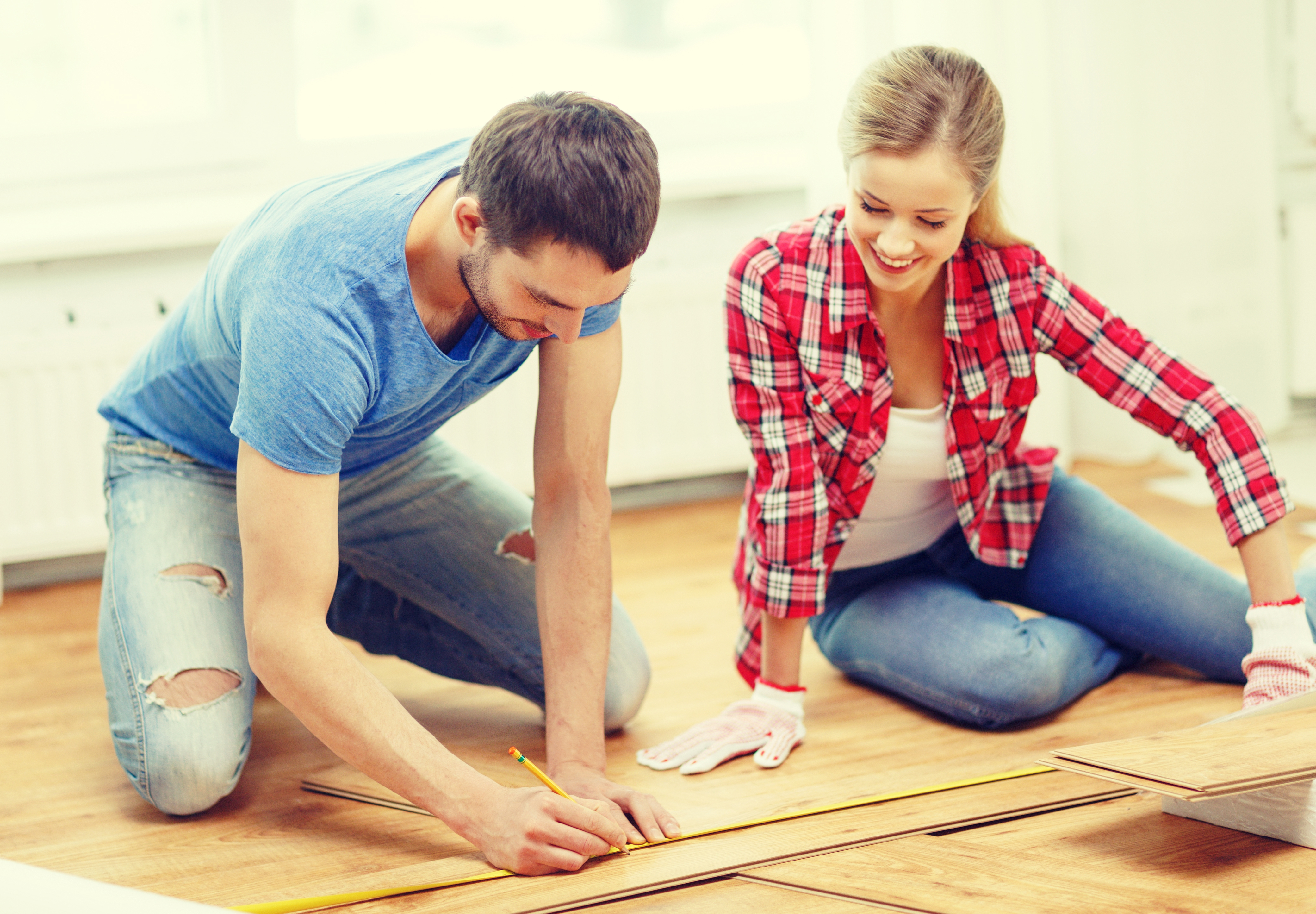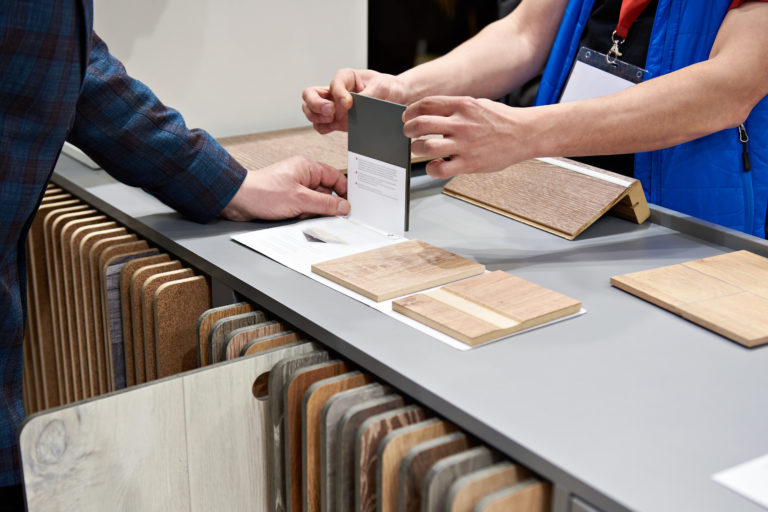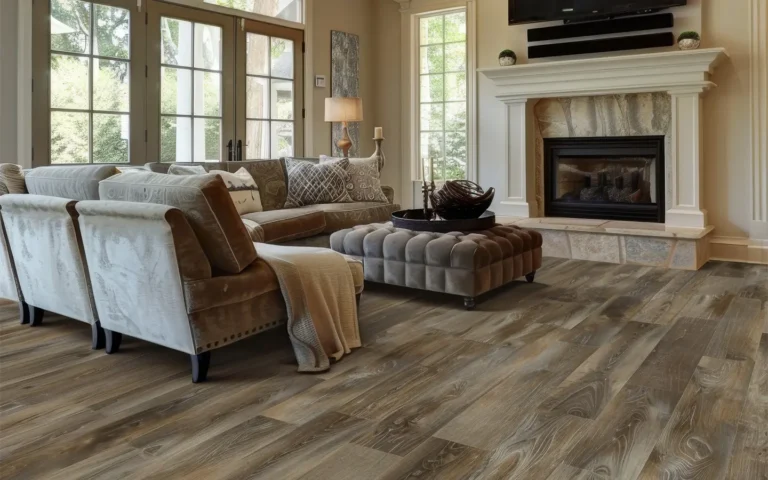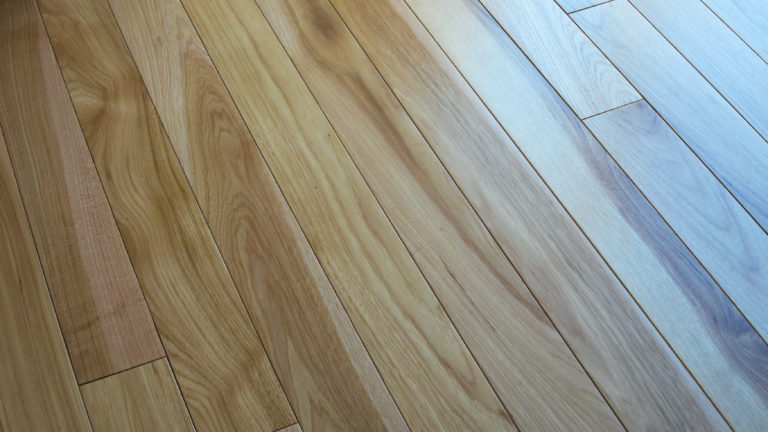This post may contain references or links to products from one or more partners of our parent company and/or subsidiaries of our parent company. For more information, visit this page.
July 16, 2020
So, you’re considering DIY wood floors but don’t know where to begin. Well friend, you’ve come to the right place!
We know there’s a ton of information out there about DIY wood floors, but it can be difficult (verging on impossible) to piece it together. Every time you find the answer to one question, two more appear.
What are the best types of wood flooring for a DIY project? How about the best hardwood floors for dogs and kids? Is a do-it-yourself flooring project even worth the hassle from a financial standpoint?
That’s why we’ve put together this complete guide to DIY wood floors for beginners and beyond—we’ll answer all of these questions, plus others you hadn’t even thought about!
We’re going to walk you through every aspect of DIY wood floors, from the cost of wood flooring to practical instructions on how to install hardwood floors. We’ll even discuss some fake wood flooring options that make DIY projects easy. Let’s jump in!
Part 1: Choosing the Best Wood Floors for Your DIY Project
So much wood. So many choices.
How do you choose between so many different types of wood flooring? Which one is going to look the best, fit your lifestyle, and not kill your budget? The choice won’t necessarily be easy, but you’ll be happy for years to come if you take the time to figure it out now. Here’s what you need to consider.
Solid vs. Engineered Hardwood
When comparing your wood flooring options, the first choice to make is between solid and engineered wood. Solid wood flooring is exactly what it sounds like: solid planks of wood that are put together to form a floor.
Engineered hardwood, on the other hand, is made up of several layers. The top layer (aka the veneer) is a thin, solid piece of real hardwood. Beneath that top layer is either high-density fiberboard or, more commonly, high-strength plywood. Sometimes, there’s a third layer of solid wood underneath that, but that all depends on the brand you choose.
The best engineered wood flooring products will often have a high-quality plywood core and a thick veneer. This thicker veneer will allow your floors to be refinished, if necessary (though this is much less of an issue if you buy prefinished hardwood flooring, as factory finishes are incredibly durable).
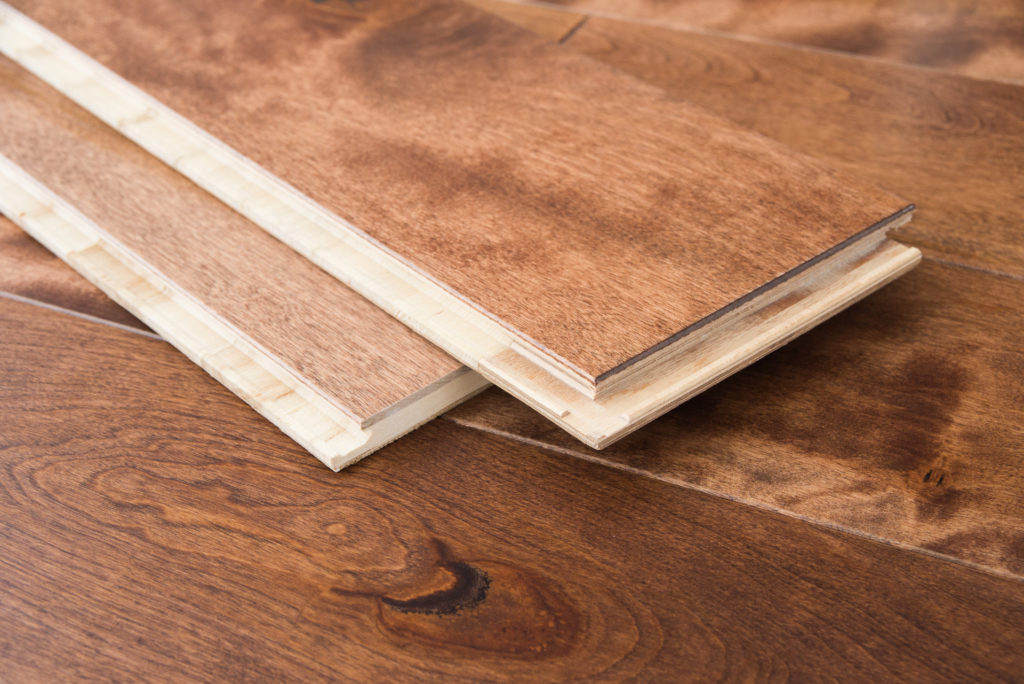
Just remember: one of the biggest engineered wood disadvantages is that it can only be refinished once or twice (if at all). Solid wood, though, can be refinished indefinitely.
On the other hand, engineered wood is less susceptible to changes in temperature and humidity than solid wood is. There are pros and cons to both options!
Best Brands of 2024
Hardwood vs. Softwood
Don’t let the name “softwood” fool you—softwood flooring isn’t pillowy-soft and it definitely doesn’t feel like carpet. The name simply refers to less-hard species of wood.
Now, if you’re choosing between hardwood and softwood for your DIY wood flooring project, there are a few things to know.
The biggest thing to remember is that hardwood is more of a scratch-resistant flooring choice. And while softwood might not make for the most durable wood flooring or the best wood flooring for dogs (again, that whole scratch-resistance thing), it does have a place!
Softwood can be an excellent choice for low-traffic areas of your home. And when they’re finished correctly, these floors can be almost as sturdy as hardwood. And if you’ve ever seen pine flooring, you’ll know they can be just as beautiful, too!
If you’re still not sure what we mean by hardwood vs. softwood floors, hardwood species include oak, maple, and walnut. Softwood species include pine, cedar, cypress, and hemlock.
Different Wood Species Have Different Needs
Now that we’ve explained the differences between hardwood, softwood, and engineered wood, you should know that different types of wood flooring will require different levels of care.
Generally speaking, you shouldn’t wet mop your wood floors. And that’s for the same reason you might not want to install wood in moisture-prone areas—wood doesn’t like water!
That said, there are water-resistant wood flooring options that will allow you to use a damp mop and not worry over spilled milk. But in general, the easiest way to keep your wood floors clean is simple: use a dust mop, vacuum, or broom daily (or at least every other day). And when possible, try to spot-treat any marks as they happen to keep your floors looking great.
If you’re one of those people that feels like a quick sweep doesn’t get your floors clean enough (we don’t blame you—sigh—kids), you may want to compare and contrast some other flooring options.
Stack up laminate vs. hardwood floors or tile vs. wood floors—you may be surprised at what you learn. But we know—nothing that comes close to the satisfaction of buying hardwood floors!
Pro tip: it is possible to bleach wooden floors if you choose a species like red oak, gum, or beech. Just don’t assume that bleach is safe for any wood floor designs that include different types of wood!
Hardwood Alternatives Can Be Great for a DIY Flooring Project
As we mentioned above, there are other flooring options that you use to get the appearance of wood in a more DIY-friendly format. In fact, there are tons of hardwood floor alternatives to choose from!
Two of today’s most popular wood floor alternatives are LVT (Luxury Vinyl Tile) and laminate. LVT is one of the best types of vinyl flooring around—it’s durable, easy to install, and waterproof thanks to its all-synthetic construction. Don’t believe us? You can even use it as an outdoor flooring option! And it’s so beautiful, we wouldn’t blame you if you did.
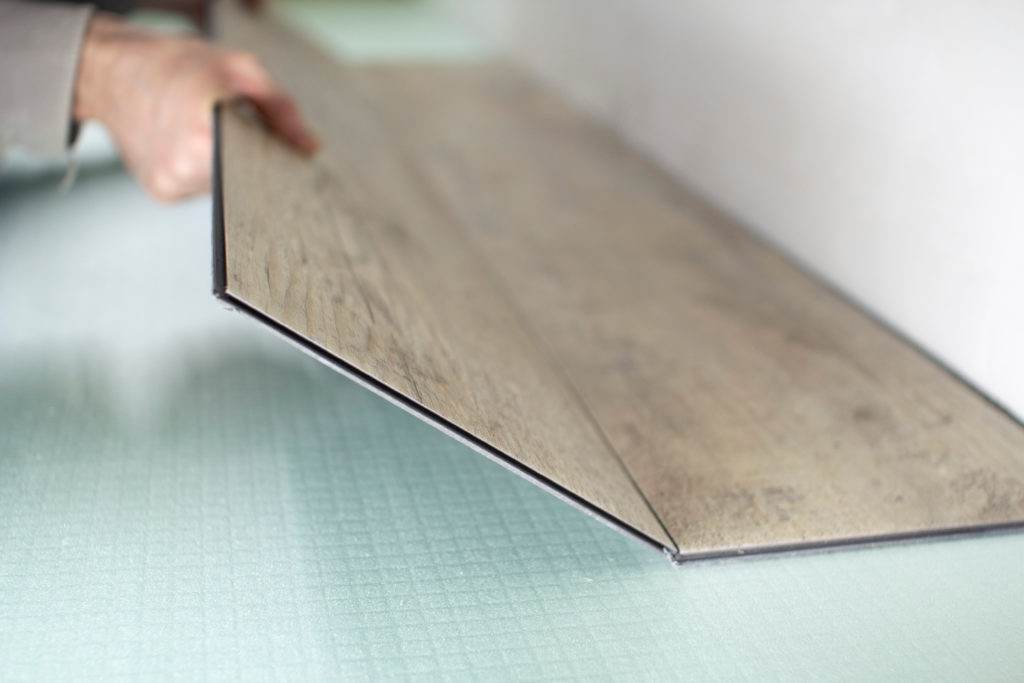
What is laminate flooring? It’s a composite material that can be made to look just like hardwood. And it’s more affordable (and sturdy) than you might think!
You should also consider taking a look at wood-adjacent materials like bamboo and cork. The best bamboo flooring and the best cork flooring are both great for DIY jobs because they offer wood-look visuals with a wide range of installation methods. Sure there are pros and cons of cork flooring (and pros and cons of engineered bamboo flooring, for that matter)—but every material has its advantages and disadvantages.
One material we would not recommend for DIY-ers: concrete flooring that looks like wood. While the results are gorgeous, learning how to replace flooring using concrete is a next-level task.
Fun fact: you can even find some types of tile that look just like wood. Seriously!
Part 2: Choosing an Installation Method for Your DIY Wood Floors
Now to the fun part of DIY wood floors: the installation! Here’s what to consider when choosing an installation method for your DIY wood flooring project:
Decide Between Staple-Down, Glue-Down, or Nail-Down Installation
You might be thinking that there’s no real difference between nail-down, staple-down, and glue-down wood flooring installation. Truth is, there’s a big difference—and it’s all based on your subflooring!
If you’re asking yourself, “what is subflooring,” the answer is relatively simple: it’s the material that’s underneath your floors.
Since it’s pretty difficult to drive nails or staples into concrete, glue-down installation is the preferred method if you’re installing wood floors directly onto this surface. That said, if you have a plywood subfloor, nail-down or staple-down installation is more traditional.
You can also add an underlayment to a concrete subfloor to allow for nail- or staple-down installation. Yes, this is an extra step, but you’ll also be adding a bit more moisture protection as well as a sound insulator.
Or Choose the DIY-Friendly Alternative: Floating Wood Floors
If you don’t want to deal with stapling, gluing, or nailing, you can always opt for floating floors. Floating floors are surfaces that sit on top of—but are not attached to—their subfloors or underlayments.
Generally, floating floors are created by using click-together flooring products. Click-together planks have special grooves that allow them to snap and lock into place, kind of like a puzzle. The strength of these connections keeps the floor in place without adhesives. Hence the name “floating floors”!
While there are some disadvantages of floating floors, one of their greatest benefits is the fact that they’re super DIY-friendly. Just measure your planks, cut them to size, and snap them together!
Engineered products sold by many of the best hardwood floor brands often come as click-together floors. Solid wood, on the other hand, is seldom sold in click-together planks. As a result, the cost to install engineered hardwood floors is generally cheaper than the cost to install solid hardwood floors.
Fun fact: these days, you can even find snap-together tile flooring!
However You Install, Be Sure to Measure Carefully!
We can not stress this enough. When you measure each room’s square footage to learn how much flooring you’ll need, add an extra 10% to cover any damaged pieces or mistakes made during installation. Seriously, unless you’re installing something totally foolproof like peel-and-stick carpet tiles, you’ll thank us for this one.
Part 3: The Cost of DIY Wood Floors vs. Professional Installation
The truth is that DIY wood floors will save you some money, but these projects create lots of considerations. Do you know how to demolish old floors without harming your subfloor? Where are you going to dispose of your old materials? Is it possible to simply install wood floors over your old flooring?
Along with questions like these, here’s what you should think about when measuring the true cost of DIY wood floors:
Raw Materials Will Range in Cost
As you’ve probably noticed, there are endless types of wood flooring to choose from. Usually, the harder and more exotic a wood species is, the more expensive it’ll be. That’s why engineered exotic wood usually costs less than solid exotic wood—it uses less of the exotic wood!
On the other hand, if you happen to choose a more common wood species (like oak), engineered and solid products will usually cost about the same amount. We’re not comparing bamboo flooring vs. laminate here—the material costs for oak are just about equal.
The Average Cost of DIY Wood Floors May Be Higher Than You Think
After you consider the costs of your wood floors, you’ll also have to factor in all the tools and other materials (like nails and glue) that you’ll need to complete the project. Your costs will remain low because you’re not paying for labor, but there are a lot of hidden costs—tools, time, disposal, shipping, etc.
And with so many variables, it’s hard to put a finger on the “average cost” for DIY wood floors. That said, if you opt for professional installation, you can expect to pay anywhere from $4-8 and $3-10 per square foot in labor for solid and engineered wood, respectively.
What Paid Installation Includes (and What it Doesn’t)
We totally won’t judge if you read all this information and decided that DIY wood floors are too much of an undertaking. Actually, that would be completely understandable.
If you decide to hire someone to install your wood floors, their price may include the actual cost of the material (bonus if they can get a contractor discount), but it usually doesn’t. You should also find out if your installer includes job supplies, any necessary tool rentals, or any added fees.
And remember: unless you negotiate a price with your flooring contractor, the quoted cost isn’t likely to include the removal of the old flooring nor its disposal.
Our advice: just buy your floors from a flooring store in your area. It’s easier, it’s more reputable, and they always know what they’re doing.
Part 4: What to Consider Before Doing a DIY Wood Flooring Project
No, we’re not trying to talk you out of doing your DIY wood flooring project—we just want to make sure you have all of the information you need before you start!
Because we’re trying to be as informative as possible, there are a few other things to consider before you proceed.
Wood Flooring Isn’t a Great Option for Every Room
We hate to break it to you: wood isn’t usually ideal for mudroom flooring, bathroom flooring, or kitchen flooring. Also, some types of wood can lighten with UV exposure, so you might want to pick another option for your sunroom flooring. And if you’re installing a heating wood floor, remember that some woods will swell if they get too hot.
Kids, pets, or high traffic may cause extra wear and tear on wood floors, too. That could mean replacing or refinishing them sooner than you’d planned, making other types of flooring a more attractive option.
Removing Your Old Flooring Could Be Harder Than You Think
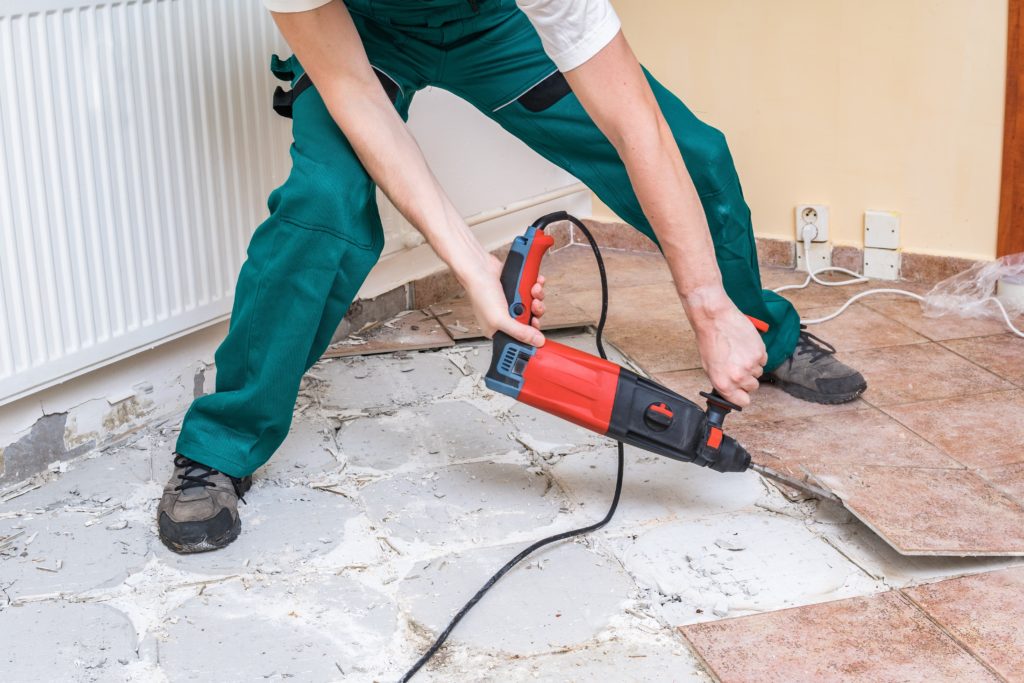
If you plan to float your wood floors over tile or cement, you probably won’t have to worry about removing old flooring. However, if your existing floor happens to be carpet, you might be in for a (not so) magic ride.
The cost to replace carpet with hardwood isn’t astronomical, but it’s worth mentioning that removing carpet is a pain! Sure, removing carpet yourself will save money—but if you haven’t done it before, be prepared for an intense workout. Just watch this YouTube video if you don’t believe us.
You Need the Right Tools and Skills for the Job
If you’ve never installed any type of flooring before, there will be a learning curve (and probably multiple trips to the hardware store.)
More than likely, you’ll have to rent the tools that you need and spend a fair amount of time watching videos, talking with professionals, and practicing.
Look, wood isn’t always the easiest flooring to install. But if you can push through the learning curve, DIY wood floors make for fun, interesting, and rewarding projects.
Do You Have Enough Time for a DIY Project
Have you ever been guilty of starting a DIY project, just to abandon it when it took too long or life got in the way?
Yeah, we’re guilty of that too.
The thing is, DIY wood flooring isn’t the type of project you can just leave for another day. You’ll need enough time to remove your old flooring, prepare your subfloor (if necessary), and install your new floors before you can even enter the room you’re re-flooring.
Granted, all of this doesn’t have to be finished in a single day, but it’s definitely not something that you can leave half-finished.
Conclusion: DIY Wood Floors are Difficult, But Rewarding
Whether you’re excited to start your DIY wood floors or whether we’ve accidentally convinced you to go with professional installation, it’s important to talk with flooring pros before breaking ground. Use this flooring stores in my area search to find a reputable flooring store and qualified installers. It’s definitely worth it!
And if you’re stuck deciding between carpet or hardwood in bedrooms, the pros and cons of tile vs. laminate, or making any other flooring decisions, here are some more resources to check out:
- Wood Flooring Types: Everything You Need to Know
- Carpet vs. Laminate: The *Real* Pros & Cons
- Pergo Extreme Reviews 2020: What Buyers are Saying
- 9 Reasons The “Carpet vs. Hardwood” Debate is Silly
- How to Install Carpet Tiles in 7 Easy Steps
- Linoleum vs. Laminate vs. Vinyl: Differences, Pros, & Cons
- Is the Cork Flooring Lowes Sells Actually Worth Buying?
About The Author

Sarah Fogle
July 16, 2020
Sarah is a full-time freelance writer and dog mom with a slight travel addiction. When she's not writing or removing fur from all surfaces, she can be found helping "supervise" her husband's retail store, planning adventures, taking naps, or adding to her already large makeup & skincare product collection.
